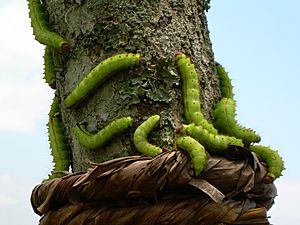Wild silk facts for kids
Wild silks have been known and used in many countries from early times, although the scale of production is far smaller than that from cultivated silkworms.
Background
Silk taken from various species has been used since ancient times, either in its natural state or after some form of preparation. Spider webs were used as a wound dressing in ancient Greece and Rome, and as a base for painting from the 16th century. Caterpillar nests were cut and pasted together to make a fabric in the Aztec Empire.
To make a woven fabric, silk threads must first be either carded and spun, or extracted as a single intact thread. Commercially reared silkworms of the species Bombyx mori (Linnaeus, 1758) are normally killed before the pupae emerge, either by pricking them with a needle or dipping the cocoons into boiling water, thus allowing the whole cocoon to be unravelled as one continuous thread. This allows a much finer cloth to be woven from the silk.
There are more than 500 species of wild silkworms in the world, although only a few are used to produce cloth. They usually produce a tougher and rougher silk than that from domesticated B. mori. Wild silks are usually harvested after the moths have left the cocoons, cutting the threads in the process, so that there is not one long thread, as with domesticated silkworms.
Wild silks are more difficult to bleach and dye than silk from Bombyx mori, but most have naturally attractive colours, particularly the rich golden sheen of the silk produced by the muga silkworm from Assam, often known as Assam silk.
The cocoon shells of wild silk moths are toughened or stabilized either by tanning (cross-linking) or by mineral reinforcements (e.g. calcium oxalate). Recently, a new method has been developed, demineralizing, which can remove the mineral reinforcements present in wild silks and enables wet reeling like the commercial silkworm.
See also
 In Spanish: Seda silvestre para niños
In Spanish: Seda silvestre para niños


